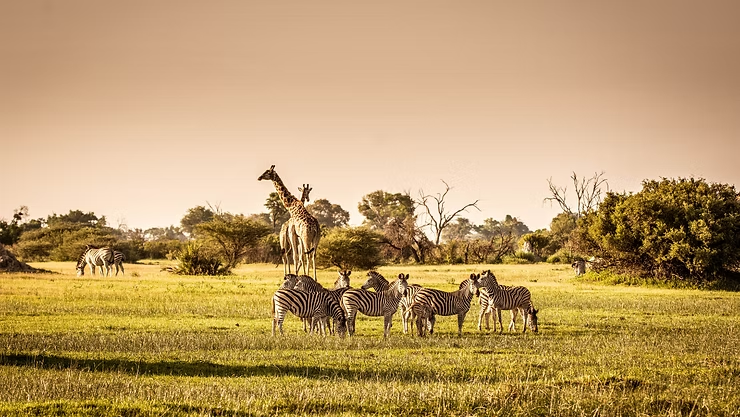Wildlife Conservation: Protecting Our Planet’s Precious Life
Wildlife conservation is essential for the health and balance of our planet. Protecting diverse flora and fauna preserves ecosystems, supports human well-being, and sustains cultural and economic benefits.
Key Takeaways
- Preserving biodiversity maintains ecosystem health and balance.
- Conservation supports economic benefits through ecotourism and sustainable practices.
- Wildlife holds cultural and spiritual significance in many societies.
- Major threats include habitat loss, illegal trade, climate change, pollution, and invasive species.
The Importance of Wildlife Conservation
Preserving Biodiversity
Biodiversity ensures ecological balance and supports endangered species. It enables scientific research, climate regulation, and advancements in medicine, agriculture, forestry, and fisheries.
Ecosystem Balance
Conserving plants and animals protects endangered species, stabilizes ecosystems, and provides chemicals beneficial for medicine and agriculture.
Economic Benefits
- Supports agriculture, forestry, and fisheries.
- Promotes ecotourism and recreational activities.
- Protected areas like national parks ensure sustainable use of natural resources.
Tourism and Recreation
Visiting wildlife reserves generates revenue for conservation, educates the public, and offers memorable experiences like safaris, birdwatching, and hiking.
Cultural Significance
- Spiritual beliefs: Many cultures consider animals sacred or symbolic.
- Traditional practices: Wildlife features in ceremonies and rituals.
- Symbolism: Animals represent values like strength, courage, and freedom.
Threats to Wildlife
Habitat Loss
Destruction from deforestation, urbanization, pollution, and natural disasters reduces suitable living spaces for wildlife.
Illegal Wildlife Trade
This multi-billion-dollar industry threatens species for exotic pets, medicine, and trophies, disrupting ecosystems and undermining conservation.
Climate Change
Temperature shifts, sea level rise, and extreme weather alter migration patterns, reproduction, and resource availability, threatening species survival.
Pollution
Water, soil, and air pollution impact ecosystems and wildlife health. Reducing chemicals, proper waste disposal, and supporting clean energy help mitigate these effects.
Invasive Species
Non-native species disrupt ecosystems, outcompete natives, introduce diseases, and reduce biodiversity. Preventing their spread is essential for conservation.
Conservation Efforts
Protected Areas
Wildlife sanctuaries, national parks, and biosphere reserves safeguard habitats and endangered species, promote ecotourism, and restore ecosystems.
Species Conservation
- Habitat restoration through reforestation and wildlife corridors.
- Captive breeding and reintroduction programs.
- Anti-poaching measures and international cooperation.
- Public education to encourage conservation awareness.
Community Involvement
Individuals can contribute by volunteering, supporting local initiatives, and participating in clean-up events and wildlife rehabilitation.
Education and Awareness
Education fosters empathy, promotes responsible behavior, and encourages citizen science participation to monitor wildlife populations.
Policy and Legislation
Enforcing wildlife protection laws, international collaboration, and providing incentives for sustainable practices are key to long-term conservation success.
Success Stories
Reintroduction Programs
Reintroducing endangered species restores populations, helps reclaim historical ranges, and raises public awareness.
Species Recovery
Efforts include habitat restoration, captive breeding, and reintroduction, requiring long-term commitment and collaboration.
Conservation Partnerships
Collaboration between organizations, governments, and communities pools resources, shares expertise, promotes community involvement, and advocates policy change.
Community-Led Initiatives
Grassroots projects restore habitats, educate locals, and provide sustainable livelihoods, empowering communities to protect their ecosystems.
Technology and Innovation
- Satellite tracking monitors species movement and habitat use.
- Drones enhance monitoring and anti-poaching efforts.
- DNA analysis supports population management and genetic diversity studies.
Conclusion
Protecting wildlife preserves ecosystems, supports human well-being, and safeguards cultural heritage. Conservation requires collective action, community engagement, and innovative solutions to ensure a sustainable future for all life on Earth.
Frequently Asked Questions
- Why is wildlife conservation important? It preserves biodiversity, maintains ecosystem balance, supports economies, and holds cultural significance.
- What are the threats to wildlife? Habitat loss, illegal trade, climate change, pollution, and invasive species.
- What conservation efforts exist? Protected areas, species conservation, community involvement, education, and policy enforcement.
- Can you share success stories? Reintroduction programs, species recovery, conservation partnerships, community-led initiatives, and technology innovations.
- Why conserve plants and animals? They maintain ecosystem balance, provide resources, and prevent species extinction.
- What are wildlife sanctuary threats? Habitat destruction, human encroachment, poaching, and illegal trade.

